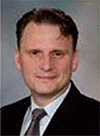Abstract
“Convergence of national interests in advancing molecular therapeutics into practice with core competencies in clinical pharmacology represents a unique opportunity to elevate the visibility of this pioneering discipline as part of the foundation of clinical and translational science.”
Keywords: clinical and translational science, enabling technologies, National Center for Advancing Translational Sciences, National Center for Clinical Research Resources
Technological advances have enabled unprecedented insight into molecular mechanisms underlying pathophysiology; however, this has surpassed the current capacity for their translation into healthcare paradigms [1,2]. Indeed, federally funded discovery programs have produced a myriad of potential diagnostic and therapeutic targets that could individualize disease management [3]. Paradoxically, these discoveries languish, reflecting limitations in facilities, resources and the skilled knowledge-based workforce required for their translation into new patient management algorithms [4]. Compounding these challenges is the reality that 95% of promising therapies brought into clinical development in the private sector ultimately fail because of limitations in efficacy or unacceptable toxicities [4,5]. To rebalance the equation and bring translational closer to discovery science, a new National Center for Advancing Translational Sciences is being created at the NIH. This center will advance novel molecular discoveries into technologies with a tractable risk–benefit ratio that appeals to private sector investment [6]. It embraces a contemporary vision of the investigational continuum from molecules to patients and populations [4], shifting translation from a focus on therapeutics that palliate, to risk stratification that prevents, disease [7,8]. This national initiative also aims to nucleate a public–private partnership in which science drives translation and clinical development to amplify efficiencies and reduce risks associated with improving patient care [4].
Beyond crystallizing activities along the translational continuum, the new center will develop the next generation of clinical and translational investigators. Rebalancing the equation to equilibrate discovery and translation requires a cadre of investigators fluent in the vocabulary, concepts and strategies of the laboratory and clinic, enabling the integration of new, often disparate, domains [9]. Furthermore, it requires a shift in professional culture that incents scientific teams, rather than rewarding individual achievements [1]. This vision recognizes the need to create a brand for clinical and translational science that attracts the best and brightest minds into training programs, to produce a multidisciplinary, complementary workforce ensuring the equipoise between discovery and translation [9–11].
“…95% of promising therapies brought into clinical development in the private sector ultimately fail because of limitations in efficacy or unacceptable toxicities.”
The new center will embrace the discipline of clinical pharmacology as one key element in creating this professional identity [101,102]. This recognition underscores the position of clinical pharmacology as a discipline at the core of the emerging field of clinical and translational science [4,12,13]. A central role for clinical pharmacology in this scientific revolution reflects its pioneering position as the original discipline bridging the laboratory bench and patient bedside. Rooted in the earliest inquiries into the mechanism of drug action, the discipline focuses on two fundamental questions [14]: What do drugs do to the body? And what does the body do to drugs? This focus on drug action and disposition established the earliest concepts and approaches underlying individualized medicine in which the right drug is used in the right patient at the right dose [2,8]. Furthermore, evolution and expansion of knowledge domains and analytical approaches anchored in the dynamic fields of pharmacokinetics and pharmacodynamics firmly position clinical pharmacologists as subject matter experts at every step along the continuum of drug discovery, development, regulation and utilization [15]. Clinical pharmacologists pioneered integration of molecular mechanisms in studies establishing drug actions in patients. They are involved in designing and implementing early- and late-stage clinical trials, including the use of placebos, elucidating molecular mechanisms underlying variability in drug responses and in the science of drug safety [14]. This primacy in translational science is evidenced by their leadership roles in international initiatives bridging the laboratory and clinic, including the Pharmacogenomics Research Network [16], the US FDA’s Critical Path Initiative [17] and the Institute of Medicine’s Committee on Qualification of Biomarkers and Surrogate Endpoints in Chronic Disease [103].
“The mandate for the new national center is to secure early adoption of the integration of discovery innovation into clinical practice in response to patients and society who seek new products and services to address unmet needs in healthcare.”
While the principles of clinical pharmacology are fundamental to translating molecular discoveries into patient-centered healthcare algorithms, the discipline has maintained a modest profile in scientific and medical communities. The practice of clinical pharmacology is primarily an academic medicine-based specialty, and its focus on cognitive, compared with procedural, activities reduces its economic imperative in the healthcare industry [18]. Furthermore, while clinical pharmacologists produce the tools underlying modern drug development, they are often wielded by subspecialty investigators outside the field, producing disciplinary anonymity [18]. Moreover, most practitioners prescribe drugs to their patients and, in that context, all identify themselves as practitioners of clinical pharmacology, diluting more fundamental contributions by the discipline [18]. This equivocation for the discipline is exemplified by the paradox of the near absence of formal didactic training in therapeutics for graduates of medical schools in the USA, in the context of the epidemic of medication errors and their impact on the healthcare system [5]. Convergence of national interests in advancing molecular therapeutics into practice with core competencies in clinical pharmacology represents a unique opportunity to elevate the visibility of this pioneering discipline as part of the foundation of clinical and translational science [101,102].
Although the new center presents an opportunity for discipline invigoration [101,102], it is essential to resist temptations to rebrand clinical pharmacology as the emerging field of clinical and translational science [9–11]. While much of translation will be served by clinical pharmacology, particularly across the discovery–application continuum, these disciplines are overlapping but not co-extensive. The core competencies of clinical pharmacology, including pharmacogenomics, pharmacokinetics, pharmacodynamics, pharmacoepidemiology, pharmacovigilence and pharmacometrics, to name but a few, are tools important to realizing the vision of translation. However, those tools are also important outside the context of clinical and translational science. They will often be applied by practitioners who identify themselves as clinical pharmacologists, but not translational investigators. Conversely, there are essential elements of clinical and translational science that go beyond the knowledge domain of clinical pharmacologists. Furthermore, clinical and translational investigators may not embrace the core competencies of clinical pharmacology as their own. In that context, the risk in rebranding and subsuming clinical pharmacology into clinical and translational science carries the potential for dilution, attrition and, ultimately, loss of those core competencies that uniquely distinguish clinical pharmacologists as subspecialists.
The National Center for Advancing Translational Sciences represents a critical next step in the evolution of the science of translation [4,104,19]. It centralizes national resources that will facilitate discovery and application across the T0–T5 translational continuum [13]. It will create a career path in translational science and medicine that will prepare the next generation of skilled investigators invested in the culture of team science. The mandate for the new national center is to secure early adoption of the integration of discovery innovation into clinical practice in response to patients and society who seek new products and services to address unmet needs in healthcare. The critical path to achieving this mandate embraces the unique knowledge domains, intellectual resources and human capital comprising clinical pharmacology as one core discipline forming the foundation for the emerging field of clinical and translational science.
Acknowledgments
Financial & competing interests disclosure
Scott A Waldman is the Samuel MV Hamilton Endowed Professor of Thomas Jefferson University (PA, USA). Andre Terzic is the Marriott Family Professor of Cardiovascular Research at the Mayo Clinic (MN, USA). The authors are supported by grants from the NIH (CA146033, CA56036, CA112147, CA95026). The authors have no other relevant affiliations or financial involvement with any organization or entity with a financial interest in or financial conflict with the subject matter or materials discussed in the manuscript apart from those disclosed.
No writing assistance was utilized in the production of this manuscript.
Biography


Contributor Information
Scott A Waldman, Department of Pharmacology and Experimental Therapeutics, Division of Clinical Pharmacology, Department of Medicine, Thomas Jefferson University, 132 South 10th Street, 1170 Main, Philadelphia, PA 19107, USA.
Andre Terzic, Divisions of Cardiovascular Diseases and Clinical Pharmacology, Departments of Medicine, Molecular Pharmacology and Experimental Therapeutics and Medical Genetics, Mayo Clinic, Rochester, MN, USA.
References
- 1.Waldman SA, Terzic A. Translational medicine in the era of health care reform. Clin. Transl. Sci 2(2), 96–97 (2009). [DOI] [PMC free article] [PubMed] [Google Scholar]
- 2.Waldman SA, Terzic A. Molecular therapeutics from knowledge to delivery. Clin. Pharmacol. Ther 87(6), 619–623 (2010). [DOI] [PubMed] [Google Scholar]
- 3.Kaiser J National Institutes of Health. A government niche for translational medicine and drug development. Science 330(6010), 1462–1463 (2010). [DOI] [PubMed] [Google Scholar]
- 4.Waldman SA, Terzic A. Clinical translational science 2020: disruptive innovation redefines the discoveryapplication enterprise. Clin. Transl. Sci 4(1), 69–71 (2011). [DOI] [PMC free article] [PubMed] [Google Scholar]
- 5.Honig PK. Comparative effectiveness: the fourth hurdle in drug development and a role for clinical pharmacology. Clin. Pharmacol. Ther. 89(2), 151–156 (2011). [DOI] [PubMed] [Google Scholar]
- 6.Butler D Translational research: crossing the valley of death. Nature 453(7197), 840–842 (2008). [DOI] [PubMed] [Google Scholar]
- 7.Clancy C, Collins FS. Patient-Centered Outcomes Research Institute: the intersection of science and health care. Sci. Transl. Med. 2(37), 37cm18 (2010). [DOI] [PubMed] [Google Scholar]
- 8.Waldman SA, Terzic A. Molecular therapy drives patient-centric health care paradigms. Clin. Transl. Sci 3(4), 170–171 (2010). [DOI] [PMC free article] [PubMed] [Google Scholar]
- 9.Skarke C, Fitzgerald GA. Training translators for smart drug discovery. Sci. Transl. Med 2(26), 26cm12 (2010). [DOI] [PubMed] [Google Scholar]
- 10.Fitzgerald G Drug development needs a new brand of science. Nature 468(7326), 869 (2010). [DOI] [PubMed] [Google Scholar]
- 11.Fitzgerald GA. Clinical pharmacology or translational medicine and therapeutics: reinvent or rebrand and expand? Clin. Pharmacol. Ther. 81(1), 19–20 (2007). [DOI] [PubMed] [Google Scholar]
- 12.Waldman SA, Kraft WK, Nelson TJ, Terzic A. Clinical pharmacology: a paradigm for individualized medicine. Biomark. Med. 3(6), 679–684 (2009). [DOI] [PubMed] [Google Scholar]
- 13.Waldman SA, Terzic A. Clinical and translational science: from bench–bedside to global village. Clin. Transl. Sci. 3(5), 254–257 (2010). [DOI] [PMC free article] [PubMed] [Google Scholar]
- 14.Dollery CT. The scientific contribution of clinical pharmacology. Eur. J. Clin. Pharmacol. 64(2), 99–106 (2008). [DOI] [PubMed] [Google Scholar]
- 15.Waldman SA, Christensen NB, Moore JE, Terzic A. Clinical pharmacology: the science of therapeutics. Clin. Pharmacol. Ther. 81(1), 3–6 (2007). [DOI] [PubMed] [Google Scholar]
- 16.Giacomini KM, Brett CM, Altman RB et al. The pharmacogenetics research network: from SNP discovery to clinical drug response. Clin. Pharmacol. Ther. 81(3), 328–345 (2007). [DOI] [PMC free article] [PubMed] [Google Scholar]
- 17.Lesko LJ. Paving the critical path: how can clinical pharmacology help achieve the vision? Clin. Pharmacol. Ther 81(2), 170–177 (2007). [DOI] [PubMed] [Google Scholar]
- 18.Maxwell SR, Webb DJ. Clinical pharmacology – too young to die? Lancet 367(9513), 799–800 (2006). [DOI] [PubMed] [Google Scholar]
- 19.Wadman M The bridge between lab and clinic. Nature 468, 877 (2010). [DOI] [PubMed] [Google Scholar]
Websites
- 101.Scientific management review board report on translational medicine and therapeutics http://smrb.od.nih.gov/dec/TMAT_Meeting_Formatted.pdf (Accessed 30 January 2011)
- 102.Rubenstein A Translational Medicine and Therapeutics Working Group, 10 November 2010. http://smrb.od.nih.gov/meetings/nov_meeting/ATTACHMENT7_TMATPresentationNov102010.pdf (Accessed 30 January 2011)
- 103.Mack A, Balogh E, Micheel CM. Perspectives on biomarker and surrogate endpoint evaluation. National Academy of Sciences http://books.nap.edu/openbook.php?record_id=13038 (Download)
- 104.Collins FS. Proposed National Center for Advancing Translational Sciences http://feedback.nih.gov/index.php/ncats/intro/ (Accessed 30 January 2011)


